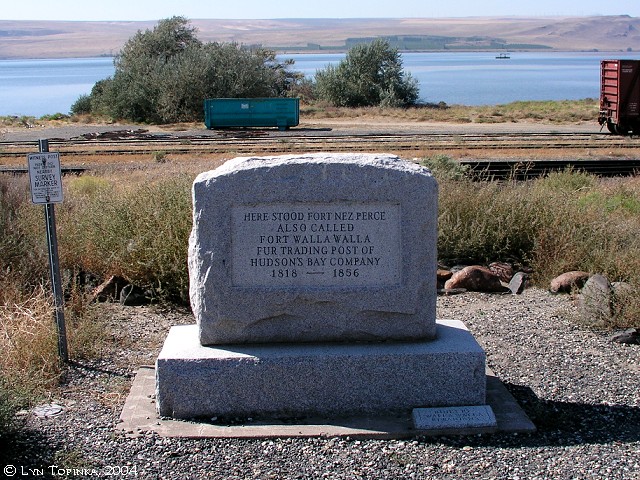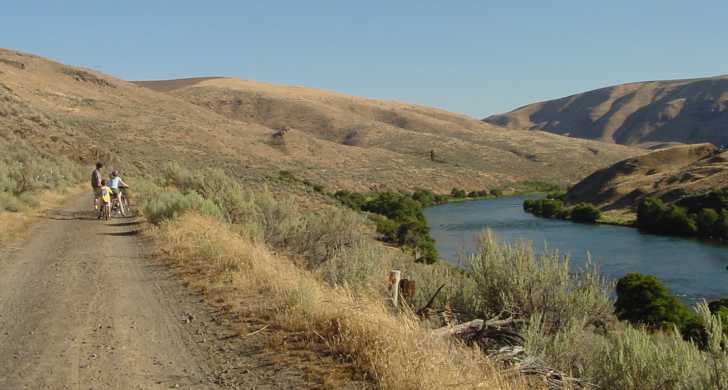
In 1817, the North West Company established Fort Nez Perce where the Walla Walla River met the mighty Columbia. In 1821, that fur trading company merged with Hudson’s Bay Company in 1821, which then operated the fort. Fort Nez Perce remained active until 1857, when the U.S. Army built a new fort nearby named Fort Walla Walla.

The early emigrants to Oregon made Fort Nez Perce a stopping point. Many first rested at the Whitman Mission after it was established in 1836, then traveled the 20 miles along the Walla Walla River to Fort Nez Perce. Imagine their joy at seeing the huge Columbia rolling toward the Pacific—the last leg of their arduous journey.
No matter how relieved they were to reach this milestone of the trek, at Fort Nez Perce the travelers had yet another a difficult decision to make: Should they abandon their wagons and teams at the fort and build or buy boats to take them down the Columbia? Or should they continue with their wagons along the river’s south shore?
Both paths were fraught with danger. And most emigrants didn’t reach this point until the middle of September or later. Winter would come soon, their supplies were running low, and they were already physically and mentally exhausted after five months on the trail.

By Water: The emigrants who decided on boat travel built large rafts for their possessions or purchased canoes from the Indians. But river travel was treacherous. In 1843, the first year of large migration to Oregon, a canoe capsized the first day after leaving Fort Nez Perce near the mouth of the John Day River downstream.
These travelers were rescued, but others making the river voyage were not so lucky. Jesse Applegate lost a son and nephew to the Columbia. This tragedy drove him to create a southern route into Oregon City a few years later, which allowed later emigrants to avoid the river route.

Moreover, travelers who took the river route had to stop for portages at both the mouth of the Deschutes River and at The Dalles, where huge cascades stopped all boat traffic. At these portages, all rafts had to be disassembled, the raft parts (or canoes) and all possessions portaged around the falls, and then reassembled, before the journey to Oregon City could continue.
Nevertheless, despite the portages, the river route was faster. It took only four or five days of travel from Fort Nez Perce to The Dalles.
By Land: Those who feared the Columbia or who wanted to bring their herds of livestock to Oregon had no choice but to travel along the river’s southern bank. These emigrants slowly rolled their worn wagons on the sandy, narrow shoreline strewn with huge boulders and backed by perpendicular cliffs rising 100 feet above the Columbia.

They had to climb these steep cliffs to ford the numerous tributaries of the Columbia, then work their way back down the western side of the gorges. Their teams were weary and could find little forage amidst the sand and sage and rock. It could take twelve yoke of oxen to manage one wagon on these hills.
Moreover, the shore route took longer—at least a week from Fort Nez Perce to The Dalles.
No wonder the later emigrants to Oregon searched out routes that avoided the Whitman Mission and Fort Nez Perce. By 1844, many Oregon Trail travelers joined the Columbia at the Umatilla River, saving days of travel. After the Whitman Massacre in 1847, this portion of the trail was seldom used.
What choice would you have made – by water or by land?




So few people know about the Nez Perce, it’s good to see this.
In reality, I probably would have stayed home all together!
I’m with Sally, I think I would have stayed home as well. And we complain about long security lines. 🙂 Interesting post!
Sally & Jill, you’re not getting into the spirit of this! (Though, frankly, I’d be sitting in my rocking chair also.)
I don’t think I could have faced the river trip, so I’d probably have opted for the sand and hills.
Theresa
[…] I’ve mentioned the grueling Barlow Road around the south slope of Mt. Hood before. Barlow Road was the last leg of the Oregon Trail for the emigrants who decided against floating down the Columbia River. […]